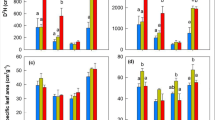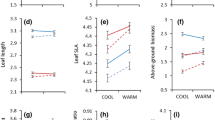Abstract
The subalpine coniferous forests on the eastern Qinghai-Tibet Plateau provide a natural laboratory for studying the effect of climate warming on terrestrial ecosystems. Research on differences between tree species in their responses to experimental warming can provide insights into their regeneration behavior and community composition under a future warmer climate. We used open-top chamber (OTC) to determine the short-term effect of two levels of air temperature (ambient and warmed) and light (full light and ca. 10% of full-light regimes) on the early growth and physiology of Betula albo-sinensis and Abies faxoniana seedlings. The OTC manipulation increased mean air temperature and soil surface temperature by 0.51 and 0.34°C, respectively, in a 60-year-old plantation and 0.69 and 0.41°C in forest openings, respectively. Warming generally increased plant growth, biomass accumulation, and advanced physiological processes for seedlings of both species. In response to warming, both tree species allocated relatively more biomass to foliage and had significantly decreased root/shoot ratios (R/S), which might provide the two species with an adaptive advantage when other environmental factors were not limiting. Warming may enhance photosynthesis in the two seedlings by increasing efficiency of PSII in terms of increases in F v/F m, photosynthetic pigment concentrations, and apparent quantum yield (Φ). However, the effects of warming on seedling growth and physiological performance varied by light conditions and species. For B. albo-sinensis seedlings, the effects of warming were pronounced only under full-light conditions, while the growth and physiological responses of A. faxoniana seedlings to warming were found only under low-light conditions. Competitive and adaptive relationships between the two species may be altered as a result of response differences to warming manipulation. The shortterm beneficial impact of warming on the early growth and development of the two species suggests that global warming may lead to changes in regeneration dynamics and species composition in subalpine coniferous forest ecosystems.
Similar content being viewed by others
References
Aerts R, Cornelissen J H C, Dorrepaal E (2006). Plant performance in a warmer world: general responses of plants from cold, northern biomes and the importance of winter and spring events. Plant Ecol, 182: 65–77
Aiken R M, Smucker A J M (1996). Root system regulation of whole plant growth. Annu Rev Phytopathol, 25: 325–346
Awada T, Radoglou K, Fotelli M N, Constantinidou H I A (2003). Ecophysiology of seedlings of three Mediterranean pine species in contrasting light regimes. Tree Physiol, 23: 33–41
Bilger W, Fisahn J, Brummet W (1995). Violaxanthin cycle pigment contents in potato and tobacco plants with genetically reduced photosynthetic capacity. Plant Physiol, 108: 1479–1486
Björkman O (1981). Responses to different quantum flux densities. In: Lange O L, Nobe P S, Ziegler H, eds. Encyclopedia of Plant Physiology. Berlin: Springer Verlag, 57–106
Cai T B, Dang Q L (2002). Effects of soil temperature on parameters for a coupled photosynthesis-stomatal conductance model. Tree Physiol, 22: 819–829
Cornelissen J H C, Castro Diez P, Hunt R (1996). Seedling growth, allocation and leaf attributes in a wide range of woody plant species and types. J Ecol, 84: 755–765
Danby R K, Hik D S (2007). Responses of white spruce (Picea glauca) to experimental warming at a subarctic alpine treeline. Glob Chang Biol, 13: 437–451
Domisch T, Finér L, Lehto T (2002). Growth, carbohydrate and nutrient allocation of Scots pine seedlings after exposure to simulated low soil temperature in spring. Plant Soil, 246: 75–86
Havranek W M, Tranquillini W (1995). Physiological processes during winter dormancy and their ecological significance. In: Smith W K, Hinckley T M, eds. Ecophysiology of Coniferous Forests. San Diego, CA, USA: Academic Press, 95–124
Hirose T, Werger M J A (1987). Nitrogen use efficiency in instantaneous and daily photosynthesis of leaves in the canopy of a Solodage alissima stand. Physiol Plantarum, 70: 215–222
Hollister R D, Webber P J (2000). Biotic validation of small open-top chambers in a tundra ecosystem. Glob Chang Biol, 6: 835–842
IPCC (Intergovernmental Panel on Climate Change) (2007). Contribution of Working Group III to the Fourth Assessment Report of the Intergovernmental Panel on climate change. In: Metz B, Davidson O R, Bosch P R, Dave R, Meyer L A, eds. Climate Change in 2007: Mitigation. Cambridge, UK: Cambridge University Press
Kauppi P, Posch M (1985). Sensitivity of boreal forests to possible climatic warming. Clim Chang, 7: 45–54
Kennedy A D (1995). Simulated climate change: are passive green-houses a valid microcosm for testing the biological effects of environmental perturbations? Glob Chang Biol, 1: 29–42
Kolek J, Kozinka V (1991). Physiology of the Plant Root System. Dordrecht: Kluwer Academic Publishers, 26
Kullman L (2002). Rapid recent range-margin rise of tree and shrub species in the Swedish Scandes. J Ecol, 90: 68–77
Lichtenthaler H K (1987). Chlorophylls and carotenoids: pigments of photosynthetic biomembranes. In: Colowick S P, Kaplan N O, eds. Methods in Enzymology. New York: Academic Press, 350–381
Liu X D, Chen B D (2000). Climatic warming in the Tibetan Plateau during recent decades. Intl J Climatol, 20: 1729–1742
Lloret F, Peñuelas J, Estiarte M (2004). Experimental evidence of reduced diversity of seedlings due to climate modification in a Mediterranean-type community. Glob Chang Biol, 10: 248–258
Marion G M, Henry G H R, Freckman D W, Johstone J, Jones G, Jones M H, Levesque E, Molau U, Parsons A N, Svoboda J, Virginia R A (1997). Open-top designs for manipulating field temperature in highlatitude ecosystems. Global Chang Biol, 3 (Supp. 1): 20–30
Maxwell K, Johnson G N (2000). Chlorophyll fluorescence-a practical guide. J Exp Bot, 51: 659–668
Mitchell A K, Arnott J T (1995). Effects of shade on the morphology and physiology of amabilis fir and western hemlock seedlings. New For, 10: 79–98
Mortensen L V (1994). Effect of carbon dioxide concentration on assimilation partitioning, photosynthesis and transpiration of Betula pendula. Roth and Picea abies (L.) Karst. seedlings at two temperatures. Acta Agric Scand B-S P, 44: 164–169
Norby R J, Edwards N T, Riggs J S, Abner C H, Wullschleger S D, Gunderson C A (1997) Temperature-controlled open-top chambers for global change research. Glob Chang Biol, 3: 259–267
Ormrod D, Lesser V M, Olszyk D M, Tingey D T (1999). Elevated temperature and carbon dioxide affect chlorophyll and carotenoids in Douglas-fir seedlings. Intl J Plant Sci, 160: 529–534
Rosenqvist E, van Kooten O (2003). Chlorophyll fluorescence: a general description and nomenclature. In: DeEll J R, Toivonen P M A, eds. Practical Applications of Chlorophyll Fluorescence in Plant Biology. Dordrecht: Kluwer Academic Publishers, 31–77
Saxe H, Cannel M G R, Johnsen O, Ryan M G, Vourlitis G (1998). Tree and forest functioning in an enriched CO2 atmosphere. New Phytol, 139: 369–400
Usami T, Lee J, Oikawa T (2001). Interactive effects of increased temperature and CO2 on the growth of Quercus myrsinaefolia saplings. Plant Cell Environ, 24: 1007–1019
Wang K Y, Kellomäki S, Zha T (2003). Modifications in photosynthetic pigments and chlorophyll fluorescence in 20-year-old pine trees after a four-year exposure to carbon dioxide and temperature elevation. Photosynthetica, 41: 167–175
Wang K Y, Yang W Q, Kellomäki S (2003). Ecological processes and sustainable mechanisms of the subalpine coniferous forests. World Sci Tech Res Dev, 5: 17–24
Yin H J, Liu Q (2005). Seed rain and soil seed banks of Picea asperata in subalpine spruce forests, western Sichuan, China. Acta Phytoecologica Sin, 29: 108–115 (in Chinese)
Yin H J, Liu Q, Lai T (2008). Warming effects on growth and physiology in the seedlings of the two conifers Picea asperata and Abies faxoniana under two contrasting light conditions. Ecol Res, 23: 459–469
Author information
Authors and Affiliations
Corresponding author
Additional information
__________
Translated from Journal of Plant Ecology, 2008, 32 (5): 1072–1083 [译自: 植物生态学报]
About this article
Cite this article
Yin, H., Lai, T., Cheng, X. et al. Warming effect on growth and physiology of seedlings of Betula albo-sinensis and Abies faxoniana under two contrasting light conditions in subalpine coniferous forests of western Sichuan, China. Front. For. China 4, 432–442 (2009). https://doi.org/10.1007/s11461-009-0046-y
Published:
Issue Date:
DOI: https://doi.org/10.1007/s11461-009-0046-y




